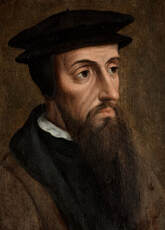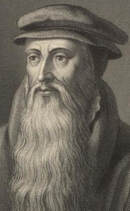Presbyterian...what's that?
Presbyterian...what's that?

Who are the Presbyterians? We're glad you asked! 'Presbyterian' is a big word, but it doesn't have to be an intimidating one. The term derives from the Greek presbyteros - a word found in the New Testament meaning 'elder' or 'senior' - and has to do with how we organize ourselves.
There are many strands or branches that make up the Christian church, generally referred to as 'denominations'. Some of these denominations have a top-down structure, with a powerful hierarchy exercising control over local congregations. Others have a bottom-up structure in which each local congregation is largely self-governing. The Presbyterian structure is a bit of both: authority flows from the top down (higher assemblies called 'Presbyteries' exercise limited authority over individual congregations) but also from the bottom up (members of the local congregation elect their own officers, known as 'elders').
The First Presbyterian Church of Meadville is part of the Presbytery of Lake Erie, which comprises 56 congregations in northwestern Pennsylvania and the westernmost corner of New York State. The Presbytery of Lake Erie, in turn, is one of 172 Presbyteries which make up the Presbyterian Church (USA). Formed in 1983 from a merger of two former denominations, the PC(USA) represents about 8,700 churches and 1.1 million members in every corner of the country. Presbyterian churches exist in many other nations as well: in fact, there are now more Presbyterians in the developing world than in the United States. And as mentioned above, the Presbyterians are just one strand of many in the rich tapestry of Christianity.
But Presbyterianism is more than just an organizational scheme: it's also about how we view Holy Scripture and our relationship to God. To understand this, we must learn a bit about John Calvin, who was born in France in 1509. As a young man Calvin studied theology, philosophy and law. He pored over the New Testament in its original Greek, and - like Martin Luther - became convinced that Christianity was overdue for a house-cleaning, so to speak: a purge of all the excess baggage it had accumulated over the centuries. Facing resistance in France, in 1536 Calvin fled to Geneva, a city which had already received a large influx of French Protestants. Calvin became a preacher in the Geneva church, and over time he gained enough civic influence to initiate sweeping reforms. He rejected the authority of the Pope and the notion of a class of celibate clergy. He denounced the idolatry which he perceived had grown up around saints, relics, and the Eucharist. In an effort to return Geneva to the model of the early church, Calvin replaced the Latin Mass with a simpler service in the language of the people. He also stripped churches of their ornate decorations, banished instrumental music, and mandated that only Psalms (rather than human-composed hymns) were suitable for divine worship. Not surprisingly, these changes aroused some controversy, but they marked the beginning of what came to be known as the 'Reformed' or 'Presbyterian' form of Christianity.
There are many strands or branches that make up the Christian church, generally referred to as 'denominations'. Some of these denominations have a top-down structure, with a powerful hierarchy exercising control over local congregations. Others have a bottom-up structure in which each local congregation is largely self-governing. The Presbyterian structure is a bit of both: authority flows from the top down (higher assemblies called 'Presbyteries' exercise limited authority over individual congregations) but also from the bottom up (members of the local congregation elect their own officers, known as 'elders').
The First Presbyterian Church of Meadville is part of the Presbytery of Lake Erie, which comprises 56 congregations in northwestern Pennsylvania and the westernmost corner of New York State. The Presbytery of Lake Erie, in turn, is one of 172 Presbyteries which make up the Presbyterian Church (USA). Formed in 1983 from a merger of two former denominations, the PC(USA) represents about 8,700 churches and 1.1 million members in every corner of the country. Presbyterian churches exist in many other nations as well: in fact, there are now more Presbyterians in the developing world than in the United States. And as mentioned above, the Presbyterians are just one strand of many in the rich tapestry of Christianity.
But Presbyterianism is more than just an organizational scheme: it's also about how we view Holy Scripture and our relationship to God. To understand this, we must learn a bit about John Calvin, who was born in France in 1509. As a young man Calvin studied theology, philosophy and law. He pored over the New Testament in its original Greek, and - like Martin Luther - became convinced that Christianity was overdue for a house-cleaning, so to speak: a purge of all the excess baggage it had accumulated over the centuries. Facing resistance in France, in 1536 Calvin fled to Geneva, a city which had already received a large influx of French Protestants. Calvin became a preacher in the Geneva church, and over time he gained enough civic influence to initiate sweeping reforms. He rejected the authority of the Pope and the notion of a class of celibate clergy. He denounced the idolatry which he perceived had grown up around saints, relics, and the Eucharist. In an effort to return Geneva to the model of the early church, Calvin replaced the Latin Mass with a simpler service in the language of the people. He also stripped churches of their ornate decorations, banished instrumental music, and mandated that only Psalms (rather than human-composed hymns) were suitable for divine worship. Not surprisingly, these changes aroused some controversy, but they marked the beginning of what came to be known as the 'Reformed' or 'Presbyterian' form of Christianity.

Living in Geneva during the time of Calvin's reforms was a Scottish clergyman named John Knox (c.1513-1572), who embraced Calvin's ideas with enthusiasm. In 1559 Knox returned to Scotland where his preaching rapidly put him at the forefront of the Protestant movement. Presbyterianism eventually became the dominant form of the faith in Scotland. With the opening up of western Pennsylvania for settlement following the American Revolution, large numbers of Scots and Scots-Irish (Ulster Scots) poured into the frontier to farm the fertile land, bringing their religion with them. Meadville was founded in 1788, and the First Presbyterian Church of Meadville was organized twelve years later with Joseph Stockton as its first minister.
Since that time, the pendulum has swung back towards the center as Presbyterians have come to realize that the first 1500 years of Christianity are not the exclusive property of the Roman Catholic Church but are part of our own heritage as well. Thus Presbyterian worship may now include elements which John Calvin originally opposed: instrumental music, robed choirs, ornately decorated churches, and hymns in addition to psalms. While mindful of Calvin's warning against turning these things into idols in their own right, we recognize that some people encounter God through beautiful art and music, in the same way that others encounter God through preaching or through prayer.
In short, Presbyterians are imperfect people who know that we are loved by a perfect God! We don't have all the answers, but we're willing to ask the tough questions. We tend to honor our traditions, but we also don't believe that we're the only ones doing things the "right" way. And we believe that Jesus was serious about loving our neighbor -- thus we engage in mission projects, both local and international, to try to help society's most vulnerable people. So whether you're a twentysomething or a retiree, a "Cradle Christian" or a spiritual searcher, a lifelong resident of Crawford County or a newcomer from elsewhere, we invite you to come see for yourself what God is doing in our church today.
Since that time, the pendulum has swung back towards the center as Presbyterians have come to realize that the first 1500 years of Christianity are not the exclusive property of the Roman Catholic Church but are part of our own heritage as well. Thus Presbyterian worship may now include elements which John Calvin originally opposed: instrumental music, robed choirs, ornately decorated churches, and hymns in addition to psalms. While mindful of Calvin's warning against turning these things into idols in their own right, we recognize that some people encounter God through beautiful art and music, in the same way that others encounter God through preaching or through prayer.
In short, Presbyterians are imperfect people who know that we are loved by a perfect God! We don't have all the answers, but we're willing to ask the tough questions. We tend to honor our traditions, but we also don't believe that we're the only ones doing things the "right" way. And we believe that Jesus was serious about loving our neighbor -- thus we engage in mission projects, both local and international, to try to help society's most vulnerable people. So whether you're a twentysomething or a retiree, a "Cradle Christian" or a spiritual searcher, a lifelong resident of Crawford County or a newcomer from elsewhere, we invite you to come see for yourself what God is doing in our church today.
Copyright © 2024
